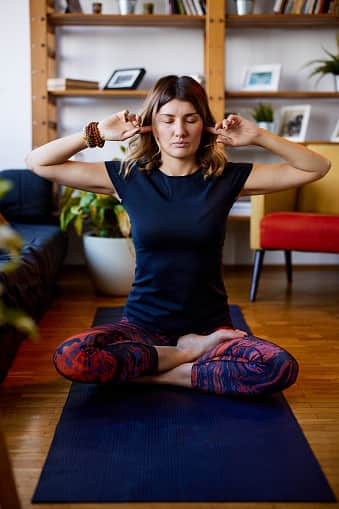If you’re someone who frequently experiences anxiety, chances are you already know that breathing can play a big role in bringing you back into the present, essentially calming you down. But did you know there are all kinds of different breathing techniques you can use to do so?
One of them becoming increasingly popular of late is the hummingbird breathing technique, also referred to as bhramari breathing, bhramari pranayama or bee breathing.
“I recommend hummingbird breathing as a technique to support falling to sleep, however, you can also use it to calm yourself during times of stress or anxiety, such as dealing with something bad at work,” says Dr Carmel Harrington, Sleep Doctor and ambassador for In Essence. “It is also useful in meditation.”
So, how do you practice hummingbird breathing? Though it can be practiced anywhere, ideally, you’ll be seated comfortably on the floor, cross-legged and with hips elevated on a cushion or blanket. Once you’re seated, close your eyes or lower your gaze, become aware of your surroundings — the feel of your legs on the ground or cushion — and lengthen through your spine and open your chest.
Then, relax your face and jaw, gently close your lips and start breathing in and out through your nose. While there are various finger placements, you can simply place both of your index fingers inside each of your ears, place your index fingers on your forehead above your eyebrows, while your middle and ring finger cover your eyes or you can place your index and middle finger over your eyes and your ring finger under your nose.

Place both of your index fingers inside each of your ears, then inhale through your nose and then slowly exhale through your mouth making a humming or buzzing sound, either out loud or in your mind, gently pushing on your cartilage as you do.
Go for six cycles of breath or however long it takes for your body to feel relaxed and your mind to quieten. When you feel you’ve calmed down, keep your eyes closed and observe the sensations in your body and the stillness in your mind.
“When you are anxious, your breathing rate goes right up to ten or twelve breaths per minute,” says Dr Harrington. “If you do the hummingbird breathing, you’ll find after a minute or so, it goes down to six or seven. Your blood and heart rate go down and you can think better.
“When your breathing rate is high it is sending a crisis mode message to the prefrontal cortex of the brain, shutting down good decision making. Slow down fight and flight mode by employing the hummingbird breathing technique as it tells the brain to slow down in times of crisis. You should feel calmer after having practiced it, thus better able to relax and get to sleep.”
Why the humming or buzzing, you ask? Basically, we hum when we’re happy. In this technique, we’re doing the reverse — humming to make ourselves reach that state of contentment. So, next time you’re feeling anxious or can’t get to sleep, why not try giving it a go?
Read more stories from The Latch and subscribe to our email newsletter.







